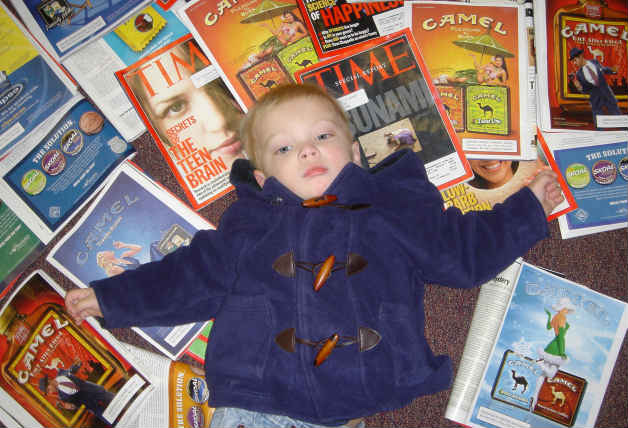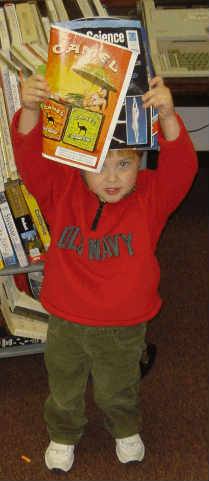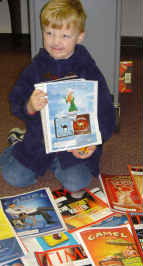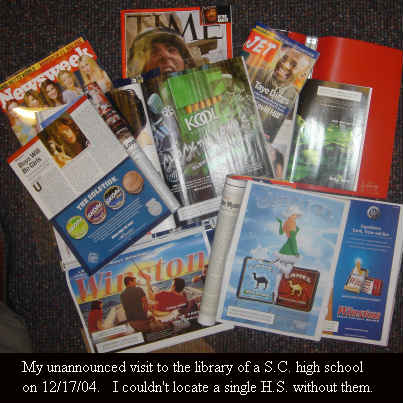
Time Inc. Tobacco Ads Trap & Harvest Teens in School
How America's schools and youth are being intentionally targeted
WARNING: Smoking nicotine is extremely addictive. It may only take one cigarette to keep you coming back for life. Once hooked there is a substantial likelihood that you will smoke yourself to death.
Time, Inc. - A Heritage of Harvests
Section III (a) of the 1998 Master Settlement Agreement -- agreed to by all major tobacco companies -- is entitled "Prohibition on Youth Targeting" and states, "No Participating Manufacturer may take any action, directly or indirectly, to target Youth within any Settling State in the advertising, promotion or marketing of Tobacco Products ..." If knowingly sending tobacco ads inside public schools isn't intentionally targeting youth then what is?
Through a process known as "selective binding," since 1989 Time Inc. and its 130+ magazine empire has had the technology to protect America's youth by creating different advertising versions of each magazine. Yes, it has had the ability to remove all tobacco ads from all copies of Time, Popular Science, Field & Stream, People and Sports Illustrated, on which mailing labels clearly indicated that the magazine version was destined for a public school, a college or a public library.
But selective binding also brought obvious abuse potential as acknowledged in a 1990 TIME editorial. By 2003 it was boasting that a "magazine like TIME has many thousands of different versions." Which version is Time Inc. today sending into America's classrooms? Sadly, the below images show 2004 ads that Time Inc. flooded locations that it must have known were flooded with young immature and impressionable minds. But why?

Yes, sadly, untold thousands of high schools across America are today knee deep in Time Inc. tobacco advertising. In light of highly refined selective binding technology, what possible excuse could Time Inc. give for bringing tobacco companies inside schools and subjecting underage minds to the most influential marketing the tobacco industry has yet devised?
Wrong Lessons Being Taught
Imagine the lessons imparted when your school magazine reading assignment teaches you that you have not yet lived, tasted real flavor, visited Marlboro country, or stirred your senses until you've smoked nicotine. What predator would stoop so low as to push an extremely addictive drug, in candy-coated form, upon young developing minds while trying to learn inside their classroom or library? Imagine the subtle yet repetitive magazine lessons that smoking nicotine will bring you lots of new friends, make you look cool, help you break free, feel more adult, or fit in with peers. I submit that these ads are not there by chance. They are there because Time Inc. and its "partner," the tobacco industry, want them there.
Yes, sixteen years ago selective binding gave Time Inc. the ability to take immediate steps to protect America's youth from ads intentionally designed to motivate those reading them to want to use a chemical more addictive and harder to beat than heroin or cocaine, a chemical that if smoked could cost them 13 to 14 years of life. But instead of protecting them, the evidence strongly suggests that Time Inc. may, to this day, be intentionally targeting them. Take a closer look and draw your own conclusions.
Time Inc.'s Nicotine Addiction Industry Partnership
Though tobacco litigation, millions of once secret tobacco industry documents are now available and can be searched using key words. But before looking at a couple of key selective binding documents, if you were a tobacco company and fully aware that 90% of all adult smokers became hooked while children or teens, what means would you have to recruit replacement smokers for the 440,000 nicotine addicts who smoke themselves to death each year? You'd have magazine ads, the tremendous influence of youth favorite actors smoking nicotine in movies, the neighborhood candy store and point of sale store marketing, and using campaign contributions to buy political influence in order to battle any measures intended to de-normalize nicotine addiction or protect youth.

Enter Time Warner, the world's largest media company, capable of exerting tremendous influence over which cause of death gets covered and which doesn't. Owners of America Online, Time Inc.'s 130+ magazines, Time Warner Cable, HBO, Cinemax, Netscape, Road Runner, New Line Cinema, CompuServe, TBS, CNN, and Warner Brothers, if you were in charge of the tobacco industry and needed to harvest 2,000 new youth smokers per day, where would you turn?
Enter Michael E. Miles who served as the Chief Executive Officer (CEO) of Philip Morris USA, our nation's largest tobacco company with almost a 50% market share. Mr. Miles served as Philip Morris's CEO from 1991 to 1994 before resigning and being voted to Time Warner's board of directors in 1995. Chance or protective planning?
Enter Richard D. Parsons. Mr. Parsons served on the board of directors of Philip Morris USA from 1990 to 2000, before becoming Time Warner's CEO in 2002 and its Chairman of the Board in 2003. According to a December 9, 2001 news article, Mr. Parsons almost became Philip Morris CEO in May 2001. Chance or planning?
According to a Philip Morris document dated April 25, 1994, in September of 1993, while Michael Miles was still Philip Morris CEO, Time Inc. and Philip Morris negotiated a confidentially agreement to conduct secret selective binding micro-marketing experiments. The document outlines how the two corporate giants came together at Time Inc.'s Tampa offices to merge their customer databases in order to create multiple special targeted tobacco ad versions of Sports Illustrated, People and Time, versions that each arrived at the correct destinations with 100% pin-point accuracy.
Philip Morris states that "initially, we limited our discussions to Time Inc., since they are our primary business partners and the best equipped (with the largest database) to do the job." It also contains the shocking yet still unfulfilled concern that "if we demonstrate that we CAN limit advertising to known smokers, in the future, we may be forced to do just that." With such awareness more than a decade ago, what are the odds that Time Inc. isn't today intentionally putting the tobacco industry inside schools to recruit replacement smokers?
Three brands (Marlboro, Virginia Slims and Merit) ran in each of three magazines over a three-week period and telephone follow-ups were conducted to determine whether the correct magazine ad version arrived at the correct address. "The ability of Time to deliver the right copy in the right issues was virtually perfect..." It closes by noting, "it is important to note that given legal implication, this project continues to be confidential in nature and involvement should be limited to those who need to know."
Sharing Age Info Since 1993
An earlier Philip Morris document dated September 9, 1993 shares details of the Philip Morris/Time Inc. database merger. One of the three most important database-matching factors was age. The objective was to speak to Time Inc. smokers in innovative and highly targeted ways. Philip Morris describes its relationship to Time Inc. as "a partnership."
 A June 26, 2001 Brown & Williamson document reviews the Time-Warner database. It raises serious concerns that Time Inc. may have been telling the tobacco industry where youth reside. It describes the Time Warner database as containing info on 63 million unduplicated households, all transactional data including magazines, books and videos purchased, the ages of adults, gender, marital status and the presence and ages of children.
A June 26, 2001 Brown & Williamson document reviews the Time-Warner database. It raises serious concerns that Time Inc. may have been telling the tobacco industry where youth reside. It describes the Time Warner database as containing info on 63 million unduplicated households, all transactional data including magazines, books and videos purchased, the ages of adults, gender, marital status and the presence and ages of children.
Time Inc. database records are by household. The 2001 document gives the following example. "The Smith family resides at 123 Maple Lane. Bob Smith subscribes to Sports Illustrated and Peggy Smith subscribes to People and Entertainment Weekly. There are two teenagers in the household as well."
Not only was Time Inc. able to identify households in which youth resided, a November 27, 2001 Philip Morris memo suggests that it was more than willing to help the tobacco industry connect with youth. It states, "I just got off the phone with Ed McCarrick, publisher of Time magazine ... AOL Time Warner possess a multifaceted infrastructure which could be of assistance to YSP in communicating to the youth market."
Serious Nicotine Dependency Journalism Missing
Nearly a billion dollars in annual tobacco magazine advertising not only normalizes nicotine addiction at the grassroots level across America, but keeps every magazine taking the money from ever presenting any serious journalism as to how the tobacco industry is able to lure and capture more than 700,000 new youth smokers each year. Time Inc. can never tell the whole truth about nicotine without painting itself as a major part of the problem.
One need only spend a few hours in TIME magazine's archives to discover just how little meaningful coverage has been devoted to America's #1 cause of death. TIME magazine has had 2 breast cancer covers (40,870 annual deaths) and no lung cancer cover (163,510 annual deaths). Why? Since 1990 the word heroin has appeared in 258 articles, cocaine in 476, alcohol in 820, and nicotine -- the chemical that dependency experts regard as the most addictive of all -- in just 147 articles. Keep in mind that addiction to smoking nicotine now accounts for roughly 30 times more annual deaths than all illegal drugs combined.

A Call to Arms
The following e-mail link will allow you to send seven "Letters to the Editor to seven different Time Inc. magazine editors all at once: TIME, People, Sports Illustrated, Field & Stream, Popular Science, Outdoor Life, and Entertainment Weekly.
E-mail 7 Time Inc. Magazine Editors
If you'd like to help get the tobacco industry out of your schools I'd encourage you to: (1) visit your nearest high school library or media center; (2) sit down, thumb through, and record tobacco ads in recent editions of Time, Sports Illustrated, People, Jet, Popular Science, Popular Mechanics, Field & Stream, Car & Driver, Newsweek, Outdoor Life, and Road & Track; (3) immediately report your findings to the school, the school board and all local media; and (4) write a letter to the editor describing what you found, e-mailing a copy to every newspaper in your state. This U.S. Newspapers List should help you contact them.
Our youth need our protection and they need it now!
Related Links
- Nicotine Addiction 101
- "Kids Just Don't Get It"
- Youth Nicotine Dependency Test
- Time to Boycott Time Inc.
- Fall 2004 Magazine Tobacco Ads
- Point of Sale Tobacco Marketing
- OhioMagazine now selling cigarettes
- Parent to parent e-cigarette, Juul and nicotine addiction warnings
- Kids and vaping: an ounce of prevention is worth a pound of cure
- How you can help prevent kids from vaping
- STUDENT ALERT: e-cigarettes & juuling are dangerous
- How you can help prevent kids from vaping
- How to help kids stop vaping
- 03/31/15 - ESPN helping addict teens to smoking nicotine
- India's ITC, the most reckless cigarette company on earth
- Marlboro "Maybe" ads banned by Germany for tareting youth
- Student Warning: nicotine addiction can be quick and is permanent
- American Lung Association's Not-On-Tobacco school student quit smoking program NOT effective
- 100 reasons why CVS should stop selling cigarettes
- Addiction to smoking nicotine a mental illness and disease
- Enslaved college smokers pay hefty price
- 09/29/09 - City and county council inaction hand youth to nicotine industry
- ALA's Not-On-Tobacco school student quit smoking program NOT effective
- Family Smoking Prevention and Tobacco Control Act becomes law
- Inconsistent Flavor of Campaign for Tobacco Free Kids
- Young dying smokers share nightmares online
- Obama youth nicotine dependency lessons unacceptable
- Confessions of a teenage nicotine addict
- School smoking & nicotine dependency: students helping students
- Imagine being 17, a smoker and your life being half over
- Convenience Stores - Nicotine Addiction Central
- Philip Morris revises "Raising kids who don't smoke"
